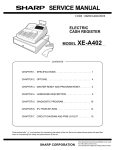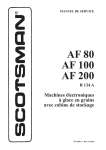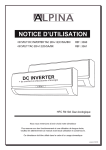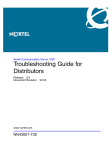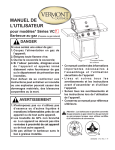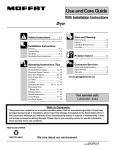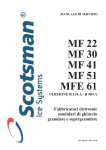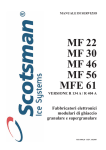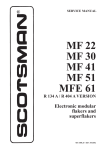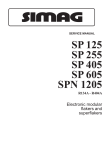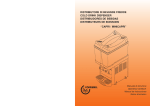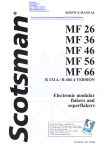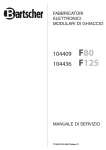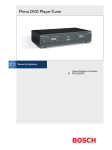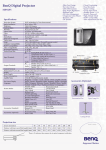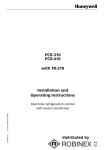Download SCOTSMAN MF 52-62-ING-REVISED
Transcript
MF 52-62 SPLIT Electronic Modular Super-Flakers Fabbricatori di Ghiaccio Granulare Machines á Glace en Supergrains Service Manual Manuale di Servizio Manuel de Service 090144.03 - REV. 02-2004 TABLE OF CONTENTS – INDICE – TABLE DES MATIERES ENGLISH ♦ ♦ ♦ ♦ ♦ ♦ ♦ ♦ ♦ ♦ ♦ ♦ ♦ ♦ ♦ Table of Contents.......................................................................................................................... Page 1 Specifications......................................................................................................................................... 2 Technical Specifications.......................................................................................................................... 2 Unpacking and Inspection....................................................................................................................... 3 Location and Levelling............................................................................................................................ 3 Typical Installation on Refrigerant Plant ................................................................................................... 4 Electrical Connections ............................................................................................................................ 4 Water Supply and Drain Connections ...................................................................................................... 4 Refrigerant System................................................................................................................................. 5 Refrigerant System Scheme.................................................................................................................... 6 Electrical System ................................................................................................................................... 7 PC Board and sensors............................................................................................................................ 7 Spare Parts............................................................................................................................................ 9 Wiring Diagram MF 52 .......................................................................................................................... 24 Wiring Diagram MF 62 .......................................................................................................................... 25 ITALIANO ♦ ♦ ♦ ♦ ♦ ♦ ♦ ♦ ♦ ♦ ♦ ♦ ♦ ♦ ♦ Indice .........................................................................................................................................Pagina 1 Specifiche.............................................................................................................................................. 2 Specifiche tecniche................................................................................................................................. 2 Disimballaggio ed Ispezione.................................................................................................................. 10 Posizionamento e Livellamento............................................................................................................. 10 Istallazione Tipica su un Impianto Frigorifero.......................................................................................... 11 Collegamenti Elettrici............................................................................................................................ 11 Alimentazione Idrica e Scarico Acqua .................................................................................................... 11 Circuito Frigorifero................................................................................................................................ 12 Schema del Circuito Frigorifero ............................................................................................................. 13 Circuito Elettrico................................................................................................................................... 14 Scheda Elettronica e Sensori ................................................................................................................ 14 Parti di Ricambio.................................................................................................................................. 16 Schema Elettrico MF 52........................................................................................................................ 24 Schema Elettrico MF 62........................................................................................................................ 25 FRANCAIS ♦ ♦ ♦ ♦ ♦ ♦ ♦ ♦ ♦ ♦ ♦ ♦ ♦ ♦ Table des matieres ................................................................................................................................. 1 Specifications......................................................................................................................................... 2 Specificatrions techniques....................................................................................................................... 2 Emplacement et mise à niveau.............................................................................................................. 17 Installation Frigorifique Traditionnelle..................................................................................................... 18 Raccordement électrique ...................................................................................................................... 18 Arrivée d’eau et vidange ....................................................................................................................... 18 Equipement frigorifique ......................................................................................................................... 19 Schema de Systeme Frigorifique........................................................................................................... 20 Circuit électrique................................................................................................................................... 21 Carte de Regulation Electronique.......................................................................................................... 21 Pièces de rechange.............................................................................................................................. 23 Schema Electrique MF 52 ..................................................................................................................... 24 Schema Electrique MF 62 ..................................................................................................................... 25 SPECIFICATIONS – SPECIFICHE - SPECIFICATIONS 405 120 830 FRONT VIEW VISTA LATERALE VUE DE FACE VUE DE COTE 535 POWER CORD CAVO ELETTR. ALIMENTATION 660 REAR VIEW FRONT SIDE TOP VIEW - VISTA DALL’ALTO VUE DE DESSUS VISTA POSTERIORE WATER INLET ¾” INGR. ACQUA ¾” ENTREE EAU ¾” MF 62 ONLY SOLO SEULEMENT SIDE VIEW VISTA FRONTALE PANNELLO FRONTALE VUE ARRIERE ½” MF 52 5/8” MF 62 REFR. OUTLET USCITA REFR. SORTIE REFR. 3/8” REFR. INLET INGR. REFR. ENTREE REFR. FACADE ICE DISCHARGE OPENINGS APERTURE SCARICO GHIACCIO DESCENTES DE GLACE 98 MF 62 ONLY SOLO SEULEMENT 245 180 WATER DRAIN SCARICO ACQUA VIDANGE 465 70 TECHNICAL SPECIFICATIONS – SPECIFICHE TECNICHE SPECIFICATIONS TECHNIQUES MODEL MODELLO MODELE VOLTAGE TENSIONE VOLTAGE AMPS AMPERE AMPS MF 52 S 230/50-60/1 0.7 MF 62 S 230/50-60/1 1.4 POWER POTENZA PUISSANCE FUSE FUSIBILE FUSIBLE REFRIGERATION REQUIREMENT POTENZA FRIGORIFERA RICHIESTA PUISSANCE FRIGORIFIQUE WATER CONSUMPTION CONSUMO ACQUA CONSOMMATION D’EAU Watts A at/a –16ºC – Watts (Kcal/hr) l/24 hrs 200 10 2325 (2000) 600 400 10 4650 (4000) 1200 2 UNPACKING AND INSPECTION LOCATION AND LEVELLING 1. Call your authorised SCOTSMAN Distributor or Dealer for proper installation. 2. Visually inspect the exterior of the packing and skid. Any severe damage noted should be reported to the delivering carrier and a concealed damage claim form filled in subject to inspection of the contents with the carrier's representative present. WARNING. This Modular Superflaker is designed for indoor installation only. Extended periods of operation at temperature exceeding the following limitations will constitute misuse under the terms of the SCOTSMAN Manufacturer's Limited Warranty resulting in LOSS of warranty coverage. 3. 1. in the selected Criteria for the selection of location include: a) Cut and remove the plastic strip securing the carton box to the skid. MIN MAX Air temperature 10°C (50°F) 40°C (100°F) Water temperature 5°C (40°F) 35°C (90°F) Water pressure 1 bar (14 psi) 5 bars (70 psi) Electr. voltage variations from voltage rating specified -10% +10% on nameplate b) Cut open the top of the carton and remove the polystyre protection sheet. c) Pull out the polystyre posts from the corners and then remove the carton. 4. Position the machine permanent location. Service access: adequate space must be left for all service connections through the rear of the ice maker. Remove the front/top panel of the unit and inspect for any concealed damage. Notify carrier of your claim for the concealed damage as stated in step 2 above. 1. Lay out on the storage bin top the plan of the ice machine as it will be located on the bin and cut one or two openings according to the Ice Maker model. 5. Remove all internal support packing and masking tape. 6. Check that refrigerant lines do not rub against or touch other lines or surfaces. 2. Install the Modular Superflaker on the storage bin pay attention to match the ice chute/s with the Bin Top opening/s. 7. See data plate on the rear side of the unit and check that local main voltage corresponds with the voltage specified on it. 3. Level the Ice Maker in both the left to right and front to rear directions by means of the adjustable legs. CAUTION. Incorrect voltage supplied to the icemaker will void your parts replacement program. 8. The machine is also equipped with pre-pounched rectangular openings on the left side panel so to have the possibility to discharge the ice through the side of the machine (not recommended). Cut the manufacturer's registration card from the back cover page of the User Manual and fill-in all parts including: Model and Serial Number taken from the data plate. Forward the completed self-addressed registration card to SCOTSMAN EUROPE/Frimont factory. 3 TYPICAL INSTALLATION ON A REFRIGERANT PLANT HAND DISCONNECT SWITCH WATER VALVE WATER FILTER MF 52-62 POWER WATER INLET ICE MAKER REFR. INLET REFR. OUTLET WATER DRAIN ELECTRICAL CONNECTIONS HAND SERVICE VALVE Since water is the most important single ingredient in producting ice you cannot emphasize too much the three items listed above. Low water pressure, below 1 bar may cause malfunction of the ice maker unit. Water containing excessive minerals will tend to produce scale build-up on the interior parts of the water system while too soft water (with too lo contents of mineral salts), will produce a very hard flaker ice. See data plate for current requirements to determine wire size to be used for electrical connections. All SCOTSMAN icemakers require a solid earth wire. All SCOTSMAN ice machines are supplied from the factory completely pre-wired and require only electrical power connections to the wire cord provided at the rear of the unit. Make sure that the ice machine is connected to its own circuit and individually fused (see data plate for fuse size). The maximum allowable voltage variation should not exceed -10% and + 10% of the data plate rating. Low voltage can cause faulty functioning and may be responsible for serious damage to the overload switch and motor windings. WATER SUPPLY Connect the 3/4" GAS male of the water inlet fitting, using the food grade flexible tubing supply with the to unit the cold water supply line with regular plumbing fitting and a shut-off valve installed in an accessible position between the water supply line and the unit. If water contains a high level of impurities, it is advisable to consider the installation of an appropriate water filter or conditioner. NOTE. All external wiring should conform to national, state and local standards and regulations. Check voltage on the line and the ice maker's data plate before connecting the unit. WATER DRAIN The recommended drain tube is a plastic or flexible tube with 18 mm (3/4") I.D. which runs to an open trapped and vented drain. When the drain is a long run, allow 3 cm pitch per meter (1/4" pitch per foot). The ideal drain receptacle is a trapped and vented floor drain. WATER SUPPLY AND DRAIN CONNECTIONS GENERAL When choosing the water supply for the ice flaker consideration should be given to: NOTE. The water supply and the water drain must be installed to conform with the local code. In some case a licensed plumber and/or a plumbing permit is required. a) Length of run b) Water clarity and purity c) Adequate water supply pressure 4 REFRIGERANT SYSTEM 4 Thermostatic expansion valve (Flica TMVX ø 2.0 mm - 2 pcs on MF 62) 5 Refrigerant evaporating pressure regulating valve (Danfoss KVP 12 on MF 52 and Danfoss KVP 22 on MF 62) The refrigerant system of the new MF 52-62 Flakers Split versions consists off: 1 Refrigerant inlet flared male connection (3/8“) 2 Refrigerant outlet flared male connection (1/2“ MF 52 and 5/8” MF 62) 3 Liquid solenoid valve The refrigerant system is supplied completely sealed with two copper caps located on the flared nuts and pre-charged with a limited quantity of R404a. 5 REFRIGERANT SYSTEM SCHEME LIQUID SOLENOID VALVE THERMOSTATIC EXPANSION VALVE REFRIGERANT INLET - LIQUID KVP REFRIGERANT OUTLET - GAS MF 52 THERMOSTATIC EXPANSION VALVE LIQUID SOLENOID VALVE REFRIGERANT INLET - LIQUID KVP REFRIGERANT OUTLET - GAS THERMOSTATIC EXPANSION VALVE MF 62 Recommended refrigerant copper tubes size are: MF 52 MF 62 LIQUID LINE GAS LINE 10 mm-3/8” 10 mm-3/8” 12 mm-1/2” 16 mm-5/8” 6 ELECTRICAL SYSTEM The Superflakers models MF 52 and MF 62 use, like their compact versions MF 51/61, the typical PC Board used in our Flaker machines. On model MF 62, in addition to the Main PC Board, it is also used the interface PC Board of the model MF 61 so to have the possibility to control the operation of two different drive motors and optical ice level controls. INTERFACE PC BOARD TERMINAL BOARD On the back side of the unit there is a open hole (plugged with a rubber cup) to electrically connect the PC Board to a remote control (Timer and/or remote switch) PC BOARD POWER BIN FULL NO WATER TOO LOW AMBIENT TEMP STAND BY WRONG ROTATION TOO HI EVAP TEMP P.C. BOARD (Data processor) protected by two fuses, integrated with three small jumpers and an I/R adjusting trimmer. Also it consists of five aligned LEDS monitoring the operation of the machine and of input terminals for the leads of the sensor probes as well as input and The P.C. BOARD, fitted in its plastic box located in the front of the unit, consists of two separated printed circuits one at high and the other at low voltage, 7 output terminals for the leads of the ice maker electrical wires. The P.C. BOARD is the brain of the system and it elaborates, through its micro processor, the signals received from the sensors in order to control the GREEN LIGHT YELLOW LIGHT (steady) (bleanking) YELLOW LIGHT RED LIGHT (steady) (bleanking) YELLOW LIGHT (steady) (bleanking) operation of the different electrical components of the ice maker (gear motor, solenoid valve, etc.). The five LEDS, placed in a row in the front of the P.C. BOARD, monitor the following situations: Unit under electrical power Unit shut-off at full storage bin Unit in shut-off procedure at full storage bin (I/R beam cutted) Unit shut-off due to a too low-water level into float tank Unit shut-off due to a too low-ambient temperature <+1°C 3 minutes delay time at start up Unit shut-off due to the wrong rotation direction of gear motor Unit shut-off due to the too low speed of gear motor Unit shut-off due to a too hi-evaporating temp. >-1°C after 10 min of operation The P.C. Board has also three small jumpers which work as described in details here below. two ice bin level light controls transmitting it to the P.C. Board for the control of the unit operation. In practical terms the Interface P.C. Board is equipped by four INLET sockets (two for the drive motor rotation/direction sensors and two for the ice level controls) and two OUTLET plugs connected to the unit P.C. Board. The JP1 (TEST) is used ONLY on the factory allows to make a rapid auto-diagnosis (when plug in) of the P.C. Board outputs to liquid solenoid valve and gear motor, by energising them in rapid sequence (2 seconds) one at the time, to make sure of their operation. EVAPORATOR TEMPERATURE SENSOR DURING THE AUTOMATIC OPERATION OF THE ICE MAKER THE JUMPER MUST BE REMOVED. The evaporator sensor probe is inserted into its tube well, which is welded on the evaporator outlet line, it detects the temperature of the refrigerant on the way out from the evaporator and signals it by supplying a low voltage current flow to the P.C. Board MicroProcessor. According to the current received, the microprocessor let the ice maker to continue its operations. In case the evaporating temperature, after 10 minutes from the unit start-up, does not go below 1°C (30°F) due to shortage of refrigerant in the system or due to the excessive condensing temperature, the evaporator sensor signal reaching the microprocessor is such to stop immediately the unit operation, with the 5th Warning YELLOW LED that blinks. WARNING. This auto-diagnosis must be performed in the shortest possible time in order to avoid frequent starts and stops of the electrical components which may cause damages to their windings and controls. The JP2, when closed, allows the skipping of the 3 minutes delay period at every start-up of the Ice Maker. NOTE. To prevent that the unit be subject to starts and stops in rapid sequence it is strongly recommended to keep these contacts always open.. FLOAT RESERVOIR WATER SENSOR SYSTEM. The JP3 on model MF 52-62 is not used and can be open or closed without any operating problem. This sensor system consist of two small stainless steel rods vertically fitted on the inner face of the reservoir cover and electrically connected to the low voltage circuit of the P.C. Board. When the cover of the reservoir is positioned in its place the tips of both the rods dip into the reservoir water and detects and signals its presence by making use of its electrical resistance. The I/R trimmer is used to modify a little the current transmitted by the Infrared Optical Ice Level Control to the PC Board. NOTE. When change the setting, it is IMPERATIVE to check up the correct operation of the Ice Level Control filling up the vertical ice chute/s with flaker ice till it break the Infrared beam between transmitter and nd receiver (2 YELLOW LED blinking). DO NOT USE HANDS. NOTE. In the event of shortage of water in the reservoir or, in case the water used is too soft (demineralized) to cause greater resistance to the current flow (conductivity lower than 30 µS) this sensor system causes the shutoff of the machine. In this situation the YELLOW LED will glow to warn of the machine shutoff and the reason why. INTERFACE P.C. BOARD (Only on MF 62 Model) Used only on MF 62 model, it allows to elaborate the signal received from one of the two gear motor rotation/direction sensors as well as from one of the 8 CONDENSER TEMPERATURE SENSOR ICE BIN LEVEL LIGHT CONTROL (Two on MF 62 Model) The condenser temperature sensor probe, located on the frame of the unit, is used (on MF 52/62) to detect the ambient temperature. When it is below +1°C (33°F) the signal transmitted to the PC Board is equivalent to keep the unit OFF till the ambient temperature rise up to +5°C. The electronic ice bin level control, located into the ice chute (one in each of the two ice chutes on MF 62 model), has the function to stop the operation of the ice machine when the light beam between the light source and the sensor gets interrupted by the flake ice which accumulates in the chute. ND When the light beam is interrupted the 2 YELLOW LED located in the front of the P.C. BOARD starts to blink. In case the light beam gets interrupted for as longer as 10 seconds, the ice machine stops with the glowing-up of the 2nd YELLOW LED (steady) to monitor the full ice bin situation. The 10 seconds of delay prevents that any minimum interruption of the light beam due to the regular ice chuting through the ice chute may stop the operation of the unit. After 10 seconds of the ice scooped out (with the resumption of the light beam between the two infrared sensor of ice level control) the ice machine resume its operation with the simultaneous extinguishing the 2nd YELLOW LED. GEAR MOTOR ROTATION AND SPEED SENSOR (Two on MF 62 Model) This safety device is housed on top of the Drive Motor (one per each motor on MF 62 model) and detects - based on Hall Effect principle - the rotating speed and rotating direction of the drive Motor. Should the rotating speed drop below 1300 r.p.m. the magnitude measured by this device is such to signal to the microprocessor to stop the unit and light-up the YELLOW LED. About the same reaction occures when the drive motor will tend to rotate in the wrong direction (counterclockwise) situation that, if it occures, will greatly affect all the freezer and gear reducer components. NOTE. To restart the unit after the shutoff caused by this safety device, it is necessary first to eliminate the cause that has generated the intervention of the device and switch OFF and ON the power line main disconnect switch. SPARE PARTS The only spare parts typical of the new MF 52/62 Split versions are listed in the following chart. All the service parts used on gear reducer as well as in the freezer assy are exactly the same of the standard model MF 51/61. MF 52 Liquid solenoid valve body Liquid solenoid valve coil Thermostatic expansion valve body Thermostatic expansion valve nozzle Refrigerant evaporating pressure regulating valve Contactor 9 620306 620306 620427 620427 620454 630119 07 48 00 08 01 02 MF 62 620306 620306 620427 620427 620454 630119 07 48 00 08 00 02 DISIMBALLAGGIO ED ISPEZIONE 1. Richiedere l’assistenza del Distributore autorizzato o rappresentante SCOTSMAN per effettuare una corretta installazione. 2. Ispezionare visivamente l’imballo esterno e il basamento in legno. Qualunque danno evidente deve essere riferito allo spedizioniere; in questo caso, procedere ad ispezionare l’apparecchio con il rappresentante dello spedizioniere presente 3. POSIZIONAMENTO E LIVELLAMENTO ATTENZIONE. Questo fabbricatore di ghiaccio NON è stato progettato per essere installato all’aperto. Periodi prolungati di funzionamento a temperature al di fuori dei seguenti limiti costituiscono uso improprio secondo i termini di garanzia SCOTSMAN e fanno decadere automaticamente il Vostro diritto alla garanzia. 1. nel luogo di I criteri per la sua scelta sono: a) Tagliare e rimuovere i nastri in plastica che fissano l’imballo al basamento. Temperatura ambiente Temperatura acqua di alimentazione Pressione dell’acqua Variazioni della tensione di rete dal valore indicato sulla targhetta b) Aprire la parte superiore dell’imballo e togliere il foglio di polistirolo protettivo. c) Sfilare gli angolari di polistirolo e quindi rimuovere l’imballo di cartone. 4. Posizionare l’apparecchio installazione definitivo. MIN 10°C 5°C 1 bar MAX 40°C 35°C 5 bar -10% +10% Lasciare un adeguato spazio per i collegamenti di servizio previsti nella parte posteriore dell’apparecchio. Togliere il pannello frontale/superiore dell’apparecchio ed ispezionare lo stesso per accertare se abbia subito danni. Notificare allo spedizioniere eventuali danni subiti come riportato al precedente punto 2. 2. Tracciare sul coperchio del contenitore la (pianta) che la macchina occuperà una volta posizionata e ricavare una o due aperture a seconda del modello di fabbricatore. 3. Porre il fabbricatore Modulare Supergranulare sul contenitore facendo attenzione ad allineare i condotti di scarico con le aperture poste sul contenitore. Livellare l’apparecchio in entrambe le direzioni (anteriore-posteriore e destra-sinistra) mediante i piedini regolabili. 5. Togliere tutti i supporti interni usati per la spedizione ed i nastri adesivi di protezione. 6. Controllare che le tubazioni del circuito refrigerante non sfreghino o siano a contatto con altre tubazioni o superfici. 4. Osservare i dati riportati sulla targhetta applicata alla parte posteriore del telaio e verificare che il voltaggio della rete elettrica disponibile corrisponda a quello dell’apparecchio riportato sulla targhetta. La macchina è inoltre provvista di aperture rettangolari prestampate sul pannello sinistro per poter scaricare il ghiaccio lateralmente (sconsigliabile). 7. ATTENZIONE. Un errato voltaggio dell’alimentazione elettrica annullerà automaticamente il Vostro diritto alla garanzia. 8. Compilare la cartolina di garanzia da ritagliare dall'ultima di copettina del Manuale d’Uso indicando sia il modello che il numero di serie dell’apparecchio rilevandoli dalla targhetta applicata al telaio. Spedire la cartolina debitamente compilata alla SCOTSMAN EUROPE/Stabilimento Frimont. 10 IMPIANTO FRIGORIFERO – INSTALLAZIONE TIPICA INTERRUTTORE A DISINSERIMENTO MANUALE VALVOLA ACQUA FILTRO ACQUA FABBRICATORE DI GHIACCIO TENSIONE INGRESSO ACQUA MF 52-62 INGRESSO RAFFREDDAMENTO SCARICO RAFFREDDAMENTO SCARICO ACQUA COLLEGAMENTI ELETTRICI VALVOLA MANUALE DI SERVIZIO a) Lunghezza della tubazione b) Limpidezza e purezza dell’acqua c) Adeguata pressione dell’acqua di alimentazione Osservare la targhetta dell’apparecchio per stabilire, in funzione dell’amperaggio indicato, il tipo e la sezione del cavo da impiegare nei collegamenti elettrici. Tutti gli apparecchi SCOTSMAN vengono forniti provvisti di cavi elettrici di collegamento e occorre solo collegare la rete di alimentazione elettrica al cavo posto sul retro dell’apparecchio. Assicurarsi che il fabbricatore sia collegato al circuito corretto e con fusibili adeguati, come indicato nella targhetta di ogni singolo apparecchio. La variazione massima di tensione non deve superare del 10% (in eccesso o in difetto) il valore di targa. Un basso voltaggio può causare un funzionamento anomalo e può essere causa di seri danni alle protezioni ed agli avvolgimenti elettrici. Poiché l’acqua è il più importante ed unico ingrediente per la fabbricazione del ghiaccio, non bisogna in nessun caso trascurare i tre punti suddetti. Una pressione dell’acqua di alimentazione inferiore ad 1 bar può causare dei disturbi di funzionamento nell’apparecchio. L’impiego di acque troppo ricche di minerali tenderà a produrre un accumulo di scaglie di ghiaccio all’interno del circuito idraulico, mentre acque troppo dolci (con un contenuto di sali minerali ridotto) produrrà un ghiaccio in granuli molto duri. ALIMENTAZIONE IDRAULICA Collegare il raccordo da 3/4 di pollice maschio del raccordo di ingresso acqua alla linea di alimentazione idraulica (utilizzando il tubo in plastica rinforzato del tipo alimentare atossico fornito con l’apparecchio) prevedendo un rubinetto d’intercettazione nei pressi dell’apparecchio. Se l’acqua di alimentazione è particolarmente ricca di impurità, è consigliabile installare filtri o depuratori appropriati. NOTA. Tutti i collegamenti esterni devono essere effettuati a regola d’arte in conformità con quanto stabilito dalle leggi locali. Prima di collegare il fabbricatore accertarsi ancora una volta che il voltaggio dell’apparecchio, specificato sulla targhetta, corrisponda al voltaggio misurato. ALIMENTAZIONE IDRAULICA E SCARICO ACQUA SCARICO ACQUA Si consiglia di usare un tubo di scarico in plastica rigida o flessibile con un diametro interno di 18 mm (3/4”) che vada in un sifone aperto e ventilato. Qualora il tubo di scarico abbia una lunghezza PREMESSA Nella scelta dell’alimentazione idraulica al fabbricatore di ghiaccio granulare si deve tenere in considerazione: 11 elevata, prevedere una pendenza di 3cm per ogni metro di lunghezza. Lo scarico ideale è un sifone a pavimento separato e ventilato. 4 Valvola di espansione termostatica (Flica TMVX ø 2.0 mm - 2 pezzi nel MF 62) 5 Valvola di regolazione della pressione di evaporazione costante (Danfoss KVP 12 nel MF 52 e Danfoss KVP 22 nel MF 62) NOTA. I collegamenti di alimentazione e scarico dell’acqua devono essere eseguiti in conformità alle leggi locali. In alcuni casi è richiesto l’intervento di un idraulico patentato e/o un’autorizzazione ad effettuare il lavoro. IMPIANTO REFRIGERANTE L’impianto refrigerante dei nuovi Granulari MF 52-62 versione Split è costituito da: 1 Raccordo maschio refrigerante (3/8“) 2 Raccordo maschio filettato uscita refrigerante (1/2“ MF 52 e 5/8” MF 62) 3 filettato ingresso Valvola solenoide liquido L’impianto refrigerante viene fornito completamente sigillato mediante due tappi di rame chiusi da bocchettoni, e precaricato con una quantità limitata di R404a. 12 SCHEMA IMPIANTO REFRIGERANTE VALVOLA SOLENOIDE VALVOLA DI INGRESSO TERMOSTATICA LIQUIDO DI ESPANSIONE INGRESSO REFRIGERANTE -LIQUIDO- KVP USCITA REFRIGERANTE - GAS - MF 52 VALVOLA DI ESPANSIONE TERMOSTATICA VALVOLA SOLENOIDE DI INGRESSO LIQUIDO INGRESSO REFRIGERANTE -LIQUIDO- KVP USCITA REFRIGERANTE - GAS VALVOLA DI ESPANSIONE TERMOSTATICA MF 62 Per il passaggio di refrigerante, si consigliano tubi in rame con i diametri seguenti: MF 52 MF 62 LINEA LIQUIDO 10 mm - 3/8" 10 mm - 3/8" LINEA GAS 12 mm - 1/2" 16 mm - 5/8" CIRCUITO ELETTRICO I modelli Supergranulari MF 52 ed MF 62 utilizzano, come le corrispondenti versioni compatte MF 51/61, la scheda elettronica tipica delle nostre macchine granulari. Nel modello MF 62 oltre alla scheda elettronica principale si utilizza anche la scheda elettronica d’interfaccia già presente sul modello MF 61 così da avere la possibilità di controllare il funzionamento di due diversi motori e lettori ottici del livello ghiaccio SCHEDA ELETTRONICA DI INTERFACCIA MORSETTIERA Sul retro della macchina vi è un’apertura chiusa da un tappo di gomma che può essere usata per collegare l’alimentazione elettrica della scheda elettronica ad un interruttore remoto) controllo remoto (timer e/o SCHEDA ELETTRONICA APPARECCHIO IN TENSIONE CONTENITORE PIENO MANCANZA ACQUA TEMP. AMB. < 1°C 3' ATTESA SENSO ROTAZ. ERR/NO ROTAZ. SOVRATEMP. EVAP. SCHEDA ELETTRONICA (Microprocessore) La SCHEDA ELETTRONICA, collocata in una scatola in plastica posta nella parte frontale dell’apparecchio, è composta da due circuiti stampati separati, ad alta ed a bassa tensione, protetti da due fusibili e integrati da tre piccoli spinotti e un potenziometro di regolazione dell'Infrarosso. Inoltre in essa si trovano cinque LEDS allineati che controllano le operazioni della macchina ed i terminali di ingresso per il collegamento dei sensori, così come i terminali di ingresso e uscita per il collegamento dei componenti elettrici della macchina. La scheda elettronica è il cervello del sistema ed elabora, attraverso il suo microprocessore, i segnali ricevuti dai sensori al fine di controllare le operazioni dei diversi componenti elettrici dell’apparecchio (motoriduttore, valvola solenoide, ecc.). LED VERDE LED GIALLO LED GIALLO LED ROSSO LED GIALLO (fisso) (lampeggiante) (fisso) (lampeggiante) (fisso) (lampeggiante) I cinque LEDS, allineati sulla parte frontale della scheda elettronica, controllano le seguenti condizioni: Apparecchio sotto tensione Arresto per contenitore ghiaccio pieno Interruzione fascio luminoso Infrarosso lettore ottico ghiaccio Arresto per livello acqua basso nella vaschetta Arresto per temperatura ambiente bassa (<+1°C) 3 minuti di attesa all’avviamento Arresto per senso di rotazione errato del motoriduttore Arresto per velocità di rotazione troppo bassa del motoriduttore Arresto per temperatura di evaporazione elevata (>-1°C) dopo 10 minuti di funzionamento La scheda elettronica ha inoltre 3 spinette che hanno le seguenti funzioni. rotazione dei motori che di uno dei due sensori livello ghiaccio, inviandoli alla scheda elettronica dell’apparecchio per la gestione del funzionamento. In pratica, la scheda elettronica di interfaccia è dotata di QUATTRO INGRESSI (due per i sensori di rotazione e due per i sensori livello ghiaccio) e di DUE USCITE collegate alla scheda principale. Presa JP1 (TEST), usata solamente durante il collaudo, consente di effettuare una rapida autodiagnosi sulle uscite della scheda elettronica alla valvola solenoide ed al motoriduttore, alimentandoli in rapida successione (2 secondi ciascuno) per accertarsi del loro funzionamento. SENSORE TEMPERATURA EVAPORATORE DURANTE IL FUNZIONAMENTO IN AUTOMATICO DELLA MACCHINA, QUESTA PRESA DEVE AVERE I CONTATTI APERTI. Il sensore temperatura evaporatore, posto all’interno di un tubo porta bulbo saldato all’uscita del cilindro evaporatore, rileva la temperatura del refrigerante aspirato e la trasmette, mediante un segnale a bassa tensione, al microprocessore della scheda elettronica. In funzione del segnale ricevuto, il microprocessore dà o meno alla macchina il consenso a proseguire nel funzionamento. Infatti, se dopo 10 min. dall’avviamento la temperatura dell’evaporatore non è inferiore a –1°C a causa della mancanza di refrigerante o dell’eccessiva temperatura di condensazione, il segnale che dal sensore temperatura evaporatore raggiunge il microprocessore è tale da arrestare immediatamente il funzionamento dell’apparecchio, facendo lampeggiare il 5° LED (GIALLO) di allarme. WARNING. Questa auto-diagnosi deve essere effettuata nel più breve tempo possibile, per evitare frequenti arresti e ripartenze dei componenti elettrici che ne potrebbero compromettere il funzionamento. La seconda presa JP2 serve per by-passare i 3 minuti di attesa ad ogni partenza. Nota. Per evitare che la macchina sia soggetta a frequenti partenze/arresti è raccomandato di tenere i contatti sempre aperti. La presa JP3, nel modello MF 52-62 non è usata e può essere lasciata chiusa o aperta senza problemi di malfunzionamento. SENSORE LIVELLO ACQUA VASCHETTA GALLEGGIANTE. Questo sensore è composto da due barrette in acciaio inossidabile fissate verticalmente alla parte interna del coperchio e collegate elettricamente al circuito a bassa tensione della scheda elettronica. Quando il coperchio viene posizionato sulla vaschetta, le estremità delle barrette risultano immerse nell’acqua e segnalano la presenza di quest’ultima alla scheda elettronica mediante un flusso di corrente trasmesso dai sali minerali disciolti. Il potenziometro I/R ha la funzione di variare la resistenza elettrica del Lettore Ottico. Agendo su di esso si può variare la corrente trasmessa alla scheda elettronica. Nota. Qualora sia variata la regolazione originale, è IMPERATIVO testare il buon funzionamento del Lettore Ottico con il ghiaccio prodotto. Questi, come interrompe il fascio luminoso all'infrarosso, fa lampeggiare il 2° LED GIALLO. NON USARE LE MANI PER QUESTO TEST. NOTA. In caso di mancanza d’acqua nella vaschetta, o in caso di acqua troppo dolce (demineralizzata) per poter fungere da conduttore di elettricità (conducibilità inferiore a 30 µS) il sensore provocherà l’arresto del produttore di ghiaccio, segnalato dall’accensione del LED GIALLO corrispondente. SCHEDA ELETTRONICA DI INTERFACCIA (Solo nel modello MF 62) Usata solo nel modello MF 62, essa consente di elaborare i segnali sia di uno dei due sensori di 15 SENSORE TEMPERATURA CONDENSATORE SISTEMA OTTICO DI CONTROLLO GHIACCIO (Due nel Modello MF 62) Il bulbo del sensore temperatura condensatore, posto sul telaio della macchina, è usato (negli MF 52/62) per rilevare la temperatura ambiente. Quando quest’ultima scende sotto +1°C il segnale trasmesso alla scheda elettronica causa l’arresto dell’apparecchio fino a quando la temperatura non sia risalita oltre i +5°C. LIVELLO Il sistema ottico per il controllo del livello del ghiaccio, posto nel condotto di scarico del ghiaccio (uno per ogni condotto nel modello MF 62), ha la funzione di arrestare il funzionamento del produttore quando il fascio luminoso tra la sorgente ed il sensore viene interrotto dal ghiaccio granulare che si accumula nel condotto. Quando il fascio luminoso viene interrotto, il 2° LED GIALLO lampeggia; nel caso in cui l’interruzione sia superiore ai 10 secondi, il funzionamento della macchina si arresta ed il SECONDO LED GIALLO si accende in continuo, ad indicare lo stato di contenitore pieno. I 10 secondi di ritardo evitano che ogni minima interruzione del fascio luminoso, dovuta alla normale caduta del ghiaccio attraverso il condotto, possa arrestare il funzionamento del fabbricatore di ghiaccio. Trascorsi 10 secondi dalla rimozione del ghiaccio (ripristino del raggio luminoso tra i due lettori ottici del sensore) il LED GIALLO si spegne facendo lampeggiare simultaneamente il LED ROSSO dei 3 minuti di attesa. SENSORE VELOCITA’ E ROTAZIONE MOTORE RIDUTTORE (Due nel Modello MF 62) Questo dispositivo di sicurezza è alloggiato nella parte superiore del motore e rileva – sfruttando il principio dell’Effetto Hall) – la velocità ed il verso di rotazione del motore. Quando la velocità di rotazione scende al di sotto dei 1300 giri/min. il segnale che il sensore rileva e trasmette al microprocessore è tale da causare l’arresto immediato dell’apparecchio e l’accensione del LED GIALLO corrispondente. Lo stesso accade quando il motore tende a girare nel verso opposto (antiorario), cosa che potrebbe provocare danni ai componenti dell’evaporatore e del motoriduttore. NOTA. Per riavviare il fabbricatore dopo l’arresto dovuto a questo dispositivo di sicurezza, è prima di tutto necessario eliminare la causa che ne ha provocato l’intervento, quindi togliere e ripristinare l’alimentazione elettrica. PARTI DI RICAMBIO Tutte le parti utilizzate sia nel motoriduttore che nell’assieme freezer sono esattamente le stesse dei modelli standard MF 51/61. Le uniche parti caratteristiche delle nuove versioni MF 52/62 Split sono riportate nella tabella seguente. MF 52 Valvola solenoide di liquido (corpo) Valvola solenoide di liquido (bobina) Valvola di espans. termostatica (corpo) Valvola di espans. termostatica (ugello) Refrigerant evaporating pressure valve Contattore 16 620306 620306 620427 620427 620454 630119 07 48 00 08 01 02 MF 62 620306 620306 620427 620427 620454 630119 07 48 00 08 00 02 Emplacement et mise à niveau Attention: Cette machine modulaire est prévue pour fonctionner à l’intérieur. Une période d’utilisation à des températures excédant les limites prescrites ci dessous sera considérée comme une mauvaise utilisation et entraînera la perte de la garantie constructeur. MINIMUM 10° 5° 1 Bar -10% MAXIMUM 40° 35° 5 Bar +10% Pour le voltage prendre en compte la valeur spécifiée sur la plaque du constructeur Accessibilité pour le service technique: un espace adéquat doit être laissé pour toutes les connections à l’arrière de la machine. 1. Mettre en place la machine en s’assurant que la chute de glace corresponde bien avec les découpes. 3. Effectuer la mise à niveau au moyen des vérins de réglage La machine est aussi équipée de panneaux prédécoupés sur le côté gauche afin d’avoir la possibilité de décharger la glace latéralement. Positionner la machine à l’emplacement sélectionné à partir des critères suivants: Temperature d’air Temperature d’eau Pression d’eau Variation du voltage 2. Positionner sur la cabine de stockage ou sur le toit de la chambre froide le plan gabarit de la machine afin d’effectuer la (MF 52) ou les découpes (MF 62) nécessaires aux chutes de glace. 17 INSTALLATION FRIGORIFIQUE TRADITIONNELLE HAND DISCONNECT SWITCH WATER VALVE WATER FILTER MF 52-62 POWER WATER INLET ICE MAKER REFR. INLET REFR. OUTLET WATER DRAIN Raccordement électrique HAND SERVICE VALVE Compte tenu de l’importance de l’eau dans la fabrication de la glace, nous mettons l’accent sur les trois points ci dessus. Une faible pression d’eau inférieure à 1 bar entraîne un mauvais fonctionnement De l’eau très minéralisée va créer des dépôts à l’intérieur du circuit d’eau, tandis que de l’eau trop douce produira une glace très dure. Contrôler la plaque du constructeur pour déterminer la section des câbles électriques pour la connection. Toutes les machines Scotsman nécessitent un raccordement à la terre. Les machines Scotsman sont complètement précablées d’origine et nécessitent uniquement le raccordement à la puissance sur le bornier à l’arrière de l’unité. S’assurer que la machine soit connectée à son propre circuit avec protection individuelle (calibrage des fusibles sur la plaque du constructeur). La variation maximale de la tension ne doit pas excéder + ou – 10% de la valeur indiquée. Un faible voltage peut entraîner un mauvais fonctionnement et être responsable de dommages liés à une surintensité sur les composants électriques. Contrôler que le voltage de la ligne corresponde bien à celui de la plaque constructeur avant toute mise en route. Arrivée d’eau Connecter le raccord ¾ mâle de l’entrée d’eau , en utilisant le flexible alimentaire fourni avec la machine, sur le robinet d’arrêt de la ligne d’arrivée d’eau froide qui doit être accessible facilement. Si l’eau contient des impuretés il est nécessaire de prévoir l’installation d’un systême de filtration adéquat. Vidange Nous recommandons l’utilisation d’un flexible de diamètre intérieur 18 mm à raccorder sur une vidange ouverte. Lorsque la vidange est éloignée vous devez prévoir une pente de 3 cm par mètre. Arrivée d’eau et vidange Généralités Pour choisir l’alimentation d’eau de la machine vous devez prendre en compte les points suivants : a) Longueur de la tuyauterie b) Qualité et pureté de l’eau c) Pression d’eau adéquate 18 Equipement frigorifique 4. Détendeur thermostatique Flica TMVX ∅ 2.0 mm, 2 sur MF 62 5. Vanne à pression évaporation constante Danfoss KVP 12 sur MF 52 et Danfoss KVP 22 sur MF 62 L’équipement frigorifique des nouvelles MF 52-62 est composé de: 1. Raccord flare 3/8” mâle entrée du liquide 2. Raccord flare (1/2” MF 52 - 5/8” MF 62) 3. Electrovanne liquide Le circuit frigorifique est hermétiquement fermé par deux capsules de cuivre vissées par les écrous des raccords flare et pré-chargé avec du gaz réfrigerant R 404 A. 19 SCHEMA DE SYSTEME FRIGORIFIQUE DETENDEUR THERMOSTATIQUE VANNE SOLENOID LIQUIDE REFRIGERANT ENTREE - LIQUIDE KVP REFRIGERANT SORTIE - GAS MF 52 DETENDEUR THERMOSTATIQUE VANNE SOLENOID LIQUIDE REFRIGERANT ENTREE - LIQUIDE KVP REFRIGERANT SORTIE - GAS DETENDEUR THERMOSTATIQUE MF 62 Dimensions des tuyaux en cuivre frigorifiques: MF 52 MF 62 Liquide 10 mm - 3/8" 10 mm - 3/8" 20 Gas 12 mm - ½" 16 mm - 5/8" Circuit électrique Sur la MF 62 en complément de la carte de régulation est aussi utilisée l’interface du modèle Compact MF 61, qui offre la possibilité de contrôler différemment le fonctionnement des deux moteurs d’entraînement et des deux cellules photo optiques de niveau de glace. Les modèles Split MF 52 et MF 62 utilisent, comme les modèles Compacts MF 51 et MF 61, la même carte de régulation électronique. INTERFACE BORNIER Sur l’arrière de la machine se trouve une trou avec un capouchin en caoutchouc permettant de raccorder l’alimentation de la carte à une commande à distance (minuterie ou interrupteur) CARTE DE REGULATION ELECTRONIQUE MACHINE SOUS TENSION CABINE PLAIN MANQUE EAU TEMP. AMB. < 1°C 3' ATTENTE ROTATION INVERSE/NO ROTAT. TEMP. EVAP. ELEVEE La carte, insérée dans sa coque plastique et positionnée en façade de la machine, est constituée de deux circuits imprimés séparés, un en haute tension, l’autre en basse tension, protégés par 2 fusibles, intégrée par trois petit "jumpers" et un potentiometre de regulation de l'Infrarouge. Elle possède 5 Leds alignées contrôlant les fonctions de la machine et les ports de connections pour les 21 sondes de régulation ainsi que la barette de connections pour la puissance. La carte est le cerveau du système et élabore à travers son micro processeur, les signaux reçus de la part des sondes afin de contrôler les différents composants électriques de la machine à glace Led Verte: Led jaune : Led jaune : Led rouge: Led jaune : allumage fixe: allumage clignotant: allumage fixe: allumage clignotant: allumage fixe: allumage clignotant: (moteur etc…). d’entraînement, Les 5 Leds suivantes: alignées vanne solenoid contrôlent les liquide, situations Sous tension Cabine de stockage pleine Coupure faiscea infrarouge sonde optique niveau glace Sécurité manque d’eau Température ambiante <+1°C Temporisation de 3 minutes au démarrage Rotation en sens inverse du moteur ou vitesse trop basse Température d’évaporation >-1°C après 10 minutes Interface (Seulement dans l'MF 62) Micro interrupteurs Utilisée seulement sur le modèle MF 62, elle permet la réception des signaux électriques en provenance des capteurs de contrôle de vitesse/sens de rotation des moteurs d’entraînement ainsi que ceux en provenance des cellules de contrôle de niveau de glace. En effet l’interface est équipée de quatre bornes d’arrivée (deux pour la vitesse/sens de rotation des moteurs et deux pour le contrôle du niveau de glace) et de deux bornes de sortie reliées à la carte de régulation. La carte à trois petit "jumpers" avec les fonctions suiventes: Le JP1 (TEST) est utilisé seulement pendante l'essai de la machine pour faire un rapide auto diagnostic des sorties de la barette de connection de la carte vers la vanne solénoïde et le moteur du réducteur, en les alimentant 2 secondes chacun pour le contrôle de leur bon fonctionnement. PENDANT LE FONCTIONNEMENT AUTOMATIQUE DE LA MACHINE, CETTE "JUMPER" DOIT ETRE TOUJOURS OUVERTE Sonde de température d’évaporation La sonde est insérée dans un tube soudé sur la sortie de l’évaporateur, elle détecte la température du réfrigérant à la sortie de l’évaporateur et en informe la carte de régulation par un retour de courant à basse tension En fonction du courant reçu le micro processeur autorise la fabrication de la glace. Dans l’hypothèse ou la température d’évaporation n’atteint pas –1° au bout de 10 minutes, le micro processeur arrête le fonctionnement de la machine et allume la cinquième Led jaune en clignotant. ATTENTION: Cette opération doit être effectuée dans un délai bref afin d’éviter les courts cycles. La deuxième prise (jumper) JP2 est utilisé pour bypasser les trois minutes d'attente a chaque demarrage. Note. Pour eviter a la machine fréquant marche/arrete, il est imperatif avoir les contacts toujours ouvertes. Sonde de niveau d’eau dans le réservoir La troisieme prise (JP3) n'est pas utilisée dans les modeles MF 52-62 et peut etre fermé ou ouverte sans problemes de malfunctionnement de la machine. Cette sonde fonctionne avec deux tiges en inox verticales fixées sur le couvercle du réservoir et reliées électriquement au circuit basse tension du micro processeur. Quand le couvercle du réservoir est en place les deux tiges plongent dans l’eau et détectent sa présence en utilisant sa résistivité. Le potentiometre I/R est utilisé pour changer la courant electrique transmis par la sonde optique a la carte. Note. Dans le cas le reglage d'origine a ete modifié, il est IMPERATIF de verifier le bonne fonctionnement de la sonde optique avec la glace produì par la machine. Comme le faisceau est coupé par la glace, le 2eme temoin joune doit clignoté. NE PAS UTILISE' LES MAINS. NOTA: En cas de manque d’eau dans le réservoir ou, en cas d’utilisation d’eau trop déminéralisée ou trop douce pour assurer la conduction du courant entre les tiges (conductivité inférieure à 30 micro siemens), le micro processeur arrête la machine et allume la troisième Led jaune. 22 Sonde de température condenseur/ambiante NOTA : pour redémarrer l’unité après l’arrêt causé par ces sécurités, il est nécessaire d’éliminer la cause qui a généré l’intervention du dispositif avant de debrancher et rebrancher de nouveau la machine a la prise electrique. Quand la température ambiante est inférieure à +1° le microprocesseur arrête la machine et allume la quatrième Led rouge, il n’autorisera le redémarrage qu’à partir de +5°. Détecteur optique de niveau de glace Dispositif de contrôle de vitesse et de sens de rotation du motoréducteur La cellule photo électrique (2 pour la MF 62) située à l’extérieur de la chute de glace détecte la présence de glace accumulée devant le faisceau optique et arrête la machine en allumant la deuxième Led jaune. Quand le faisceau est interrompu la Led Jaune Cabin Plain clignote; dans le cas ou il reste interrompu pendant plus de 10 secondes la machine s’arrête avec le même Led Jaune allumé fixe. Le délai de 10 secondes évite que le faisceau soit coupé par la chute permanente des grains de glace. Lors du prélèvement de la glace, le niveau de glace s’abaisse afin de rétablir le faisceau optique de la cellule photo électrique. Après 10 secondes en éteignant la deuxième Led jaune s'éteign et commence a clignoté le Led Rouge de 3' d'attente. Ce dispositif de sécurité est monté sur la partie supérieure du moteur (2 pour la MF 62) et détecte grâce au principe de l’effet Hall la vitesse et le sens de rotation. Lorsque la vitesse est inférieure à 1300 tours minute, le microprocesseur arrête la machine et allume la cinquième Led jaune. Il en est de même quand le moteur tente de démarrer dans le mauvais sens (sens inverse des aiguilles d’une montre) suite à une prise en glace totale de la vis sans fin, qui pourrait endommager la boite à vitesses et le Freezer. Pièces de rechange Toutes les pièces de rechange utilisées aussi bien pour le moto réducteur que pour le freezer sont les mêmes que celles des versions compactes MF 51 & 61. Les seules pièces spécifiques des nouvelles MF 52 & 62 sont listées dans le tableau ci dessous : MF 52 Corps de vanne solénoïde Bobine de vanne solénoïde Corps de détendeur sans buse Buse de détendeur Vanne à pression aspiratin constante Contacteur 620306 620306 620427 620427 620454 630119 23 07 48 00 08 01 02 MF 62 620306 620306 620427 620427 620454 630119 07 48 00 08 00 02



























